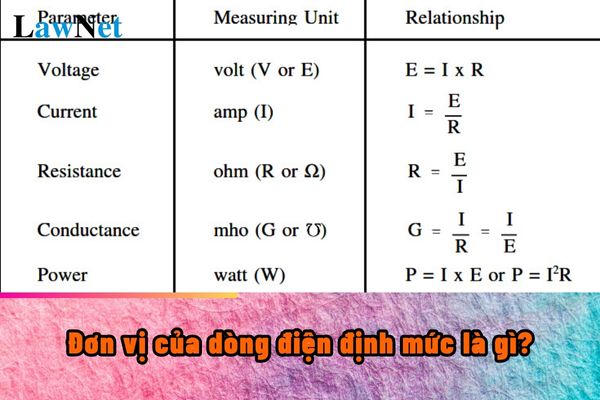What is the unit of measurement for rated current? When do students in Vietnam learn about rated current?
What is the unit of measurement for rated current?
Rated Current: This is the maximum current value at which an electrical device can operate safely and stably for an extended period.
Ampere (A): This is the unit of electric current in the International System of Units (SI). It represents the amount of electric charge moving through a cross-section of a conductor in a unit of time.
Example:
On a light bulb, you often see: "220V - 60W". The number 60W is the rated power, and from this, you can calculate the rated current of the bulb using the formula:
[ I = P/U = 60W / 220V ≈ 0.27A ]
Thus, the rated current of this bulb is approximately 0.27 Amperes.
*In summary:
Ampere (A) is the basic unit to express the rated current of electrical devices. Understanding rated current helps us use electrical devices safely and effectively.
*Note: The information is for reference only./.

What is the unit of measurement for rated current? When do students in Vietnam learn about rated current? (Image from Internet)
When do students in Vietnam learn about rated current?
Based on Section 4 of the physics curriculum of general education issued together with Circular 32/2018/TT-BGDDT, the Physics course contributes to fulfilling the requirements about the core qualities and general competencies for the grade 11 Physics course as follows:
Electric Current:
- Conduct an experiment (or rely on multimedia materials) to state that the current intensity characterizes the strength of electric current and is determined by the electrical charge passing through a conductor's straight section in a unit of time.
- Apply the expression ( I = Snve ) for a conductor carrying an electric current, where ( n ) is the density of charged particles, ( S ) is the cross-sectional area of the wire, and ( v ) is the moving speed of the particle with charge ( e ).
- Define the charge measurement unit coulomb as the amount of electric charge passing through a conductor's straight section in 1 second when there is an electric current of 1 A running through the conductor.
Thus, according to the above regulation, electric current will be studied in the grade 11 Physics course.
What is the specific competency requirement for students when studying Physics in Vietnam?
According to Section 4 of the physics curriculum of general education issued together with Circular 32/2018/TT-BGDDT, the Physics course develops and shapes students' physics competency, with the following specific manifestations:
(1) Physics Cognition
Recognize fundamental knowledge and skills about physical systems; recognize energy and waves; force and fields; identify some fields and jobs related to physics; specific manifestations include:
- Identify and state objects, concepts, phenomena, physical laws, and processes.
- Describe phenomena, physical processes; characteristics, roles of phenomena, physical processes through expressions: speaking, writing, measuring, calculating, drawing, creating diagrams, and charts.
- Find keywords, use scientific terminology, connect meaningful information logically, create outlines when reading and presenting scientific texts.
- Compare, select, categorize, and analyze phenomena, physical processes according to different criteria.
- Explain the relationship between objects, phenomena, processes.
- Identify errors and correct perceptions or explanations; make critique-related comments regarding discussion topics.
- Recognize suitable careers aligned with personal inclinations.
(2) Exploring the natural world from a physics perspective
Explore some simple and familiar physical phenomena and processes in life and the natural world in a progression; use scientific evidence to test predictions, elucidate evidence, and draw conclusions; specific manifestations include:
- Propose physics-related issues: Recognize and formulate related questions; analyze contexts to propose issues by connecting knowledge, experience and using one's language to express proposed issues.
- Make judgments and build hypotheses: Analyze problems to make judgments; develop and articulate hypotheses that need exploration.
- Plan execution: Build a logical content framework for exploration; choose appropriate methods (observation, experimentation, investigation, interviews, document research); develop an exploration implementation plan.
- Execute plan: Gather and store data from overview results, experiments, investigation; evaluate results based on analyzing and processing data using simple statistical parameters; compare results with hypotheses; explain, conclude, and adjust if necessary.
- Write, present reports, and discuss: Use language, drawings, diagrams, tables to express the exploration process and results; write reports after exploration; collaborate with partners with a positive attitude and respect other opinions, evaluations to take in actively and elaborate, defend exploration results convincingly.
- Make decisions and propose opinions, solutions: Make decisions for the explored issues; propose recommendations to apply exploration findings or further research issues.
(3) Applying learned knowledge and skills
Apply learned knowledge and skills in some simple cases, initially using mathematics as a language and tool to solve problems; specific manifestations include:
- Explain, prove a practical issue.
- Evaluate, critique the impact of a practical issue.
- Design models, develop plans, propose and implement some new methods or measures.
- Propose solutions and implement some solutions to protect nature, adapt to climate change; behave reasonably to ensure sustainable development.
In the Physics curriculum, each component of both general competencies and specific competencies mentioned above is included in each topic, each teaching content stream, in the form of requirement criteria, with varying levels.

